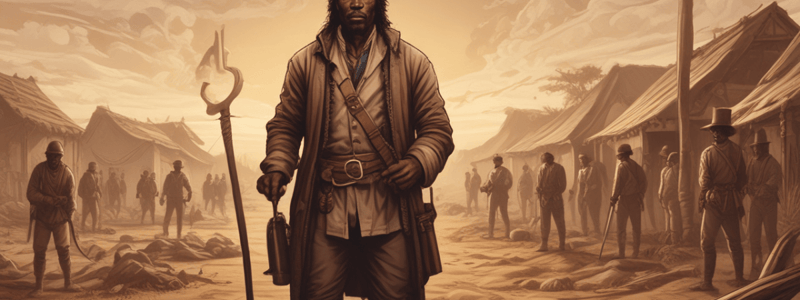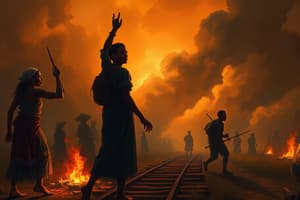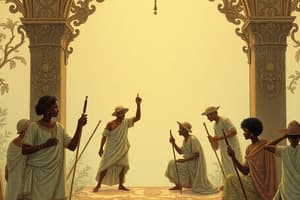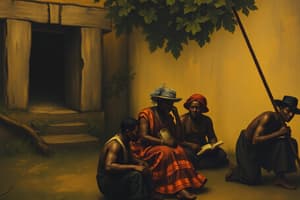Podcast
Questions and Answers
What was the dominant form of resistance in the Virgin Islands?
What was the dominant form of resistance in the Virgin Islands?
- Maritime marronage (correct)
- Burning down of the plantation
- Revolt
- Murdering of Europeans
Why were maroon societies successful?
Why were maroon societies successful?
- Because they were well-connected
- Because they were often inaccessible (correct)
- Because they were well-armed
- Because they were well-funded
What skills did individuals need to adapt to maroon society?
What skills did individuals need to adapt to maroon society?
- Fishing skills
- Sailing skills
- Farming skills
- Defense skills in guerilla warfare (correct)
Why did the Virgin Islands not support maroon societies?
Why did the Virgin Islands not support maroon societies?
What was the purpose of Creoles' familiarity with the surrounding waters?
What was the purpose of Creoles' familiarity with the surrounding waters?
What did enslaved persons secretly build to facilitate their escape?
What did enslaved persons secretly build to facilitate their escape?
What was the consequence of enslaved persons circulating the public streets after 9 p.m. without permission?
What was the consequence of enslaved persons circulating the public streets after 9 p.m. without permission?
What was mandated by the Act of 1787?
What was mandated by the Act of 1787?
What was the primary purpose of the enslaved code of 1783 in the Virgin Islands?
What was the primary purpose of the enslaved code of 1783 in the Virgin Islands?
What was the main distinction between active and passive resistance?
What was the main distinction between active and passive resistance?
What was the primary objective of rebellion in the context of enslavement?
What was the primary objective of rebellion in the context of enslavement?
What was the consequence for enslaved persons who threatened or committed violence against a European?
What was the consequence for enslaved persons who threatened or committed violence against a European?
What was the purpose of the practice of secret rituals among the enslaved?
What was the purpose of the practice of secret rituals among the enslaved?
What was a common form of passive resistance used by the enslaved?
What was a common form of passive resistance used by the enslaved?
What was the significance of the cook in the plantation household?
What was the significance of the cook in the plantation household?
What was the primary goal of insurrection in the context of enslavement?
What was the primary goal of insurrection in the context of enslavement?
Flashcards are hidden until you start studying
Study Notes
Types of Resistance
- Active resistance: using deliberate actions, sometimes violent, to bring about or force change
- Passive resistance: using nonviolent methods to resist
- Rebellion: defiance of authority or force used to control a person
- Insurrection: rebellion against the government, often involving armed conflict
- Resistance: actions demonstrating refusal to accept or comply with something
Enslavement in the Virgin Islands
- Enslavement was maintained by the use or threat of violence as punishment
- The Virgin Islands' enslaved code of 1783 restricted the movement and activities of enslaved persons
- Laws prohibited enslaved persons from possessing guns and other weapons, and punishments for violence against Europeans were harsh
- Enslaved persons were rewarded for informing on conspirators
Forms of Resistance in the Virgin Islands
- Day-to-day resistance or passive resistance: poisoning, damaging equipment, slowing down work, and mutilation
- Rebellions or active resistance: burning down plantations, revolts, and murdering Europeans
- Marronage or running away: the dominant form of resistance in the Virgin Islands, which involved maritime escape to Puerto Rico
- Maritime marronage: using boats to escape to Puerto Rico, creating problems for planters
Marronage in the Virgin Islands
- Enslaved persons built canoes or forced sailors to take them to Puerto Rico
- Planters attempted to limit the problem of runaways by having guards patrol at night and implementing laws such as the Act of 1787
- Enslaved persons who escaped sought freedom in Puerto Rico, leading to planters' petitions to London
Studying That Suits You
Use AI to generate personalized quizzes and flashcards to suit your learning preferences.




